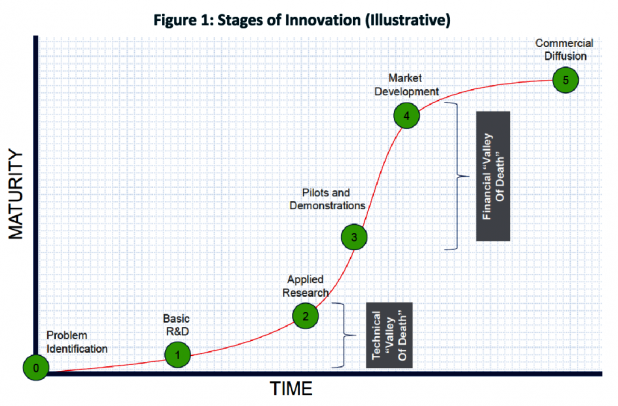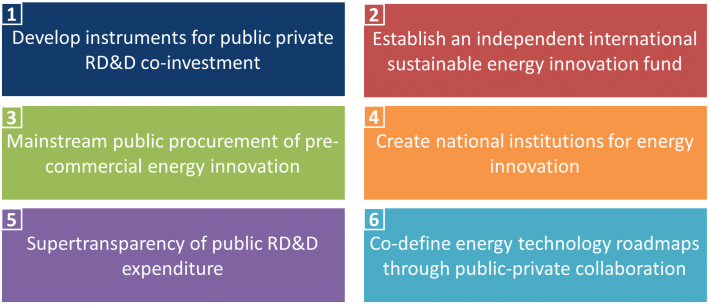
- This article was originally posted on World Economic Forum website on 22 May 2018, and reproduced courtesy of the WEF, and the author, prof Tatsuo Masuda. You can see original article here
Energy Innovation is struggling in a valley of death
Much has already been achieved in our fight against climate change, both in mitigation and adaptation. Awareness, policy, business, technology and innovation are all improving. However, the impact of climate change is gaining momentum much faster than expected, while the shift from fossil fuels to cleaner energy is slow. The International Energy Agency projects that fossil fuels will dominate way beyond 2040. Indeed, by 2040, it forecasts that such fuels will still meet 74% of primary energy demand, down from 81% in 2016.
While energy transformation is happening, increasing demand growth is limiting its net impact. In general, technological innovation faces many challenges until it is widely recognized and replicated. Photovoltaic (PV) systems, for example, took more than three decades to move from space research to broad commercial application. We simply do not have another three decades to wait for nascent technologies to mature. Substantial acceleration in sustainable energy innovation is needed now.

The technical and financial “valleys of death”, shown above, are major hurdles. Through both my work in the World Economic Forum’s Global Agenda Council on Decarbonizing Energy and in a personal capacity, I have engaged many entrepreneurs and innovators who are incubating revolutionary or disruptive technologies, including a low-cost way to separate CO2 from combustion gases.
Time and again, these innovators struggle to find funding for applied research, pilot and demonstration plants or market development. Meaningful access to supportive institutions or potential investors proves equally challenging. Those who reach out to such bodies often find themselves stonewalled by gatekeepers before even reaching the stage of serious examination. There are a multitude of promising technologies waiting to be leveraged. With the proper support and enabling environments needed to flourish, their impact on transforming our energy system could be massive.
Six bold ideas
Our fight against climate change will suffer huge losses if these technologies fail to materialize. This is a battle we cannot afford to lose. To break the stalemate and dramatically accelerate sustainable energy innovation, we have to think and act way beyond conventional wisdom. These challenges – such as climate change, solving inner-city pollution and ensuring global energy security – are unconventional. Following my participation with other experts in the World Economic Forum project “Partnering to Accelerate Sustainable Energy Innovation”, and after extensive discussions among key stakeholders in the energy innovation ecosystem, we have established “six bold ideas”.

- Develop instruments for public-private co-investment at the national or regional level to support and finance deep-tech energy innovations, reduce risks and improve the efficacy of available public and private funding. If properly designed, such instruments would not only stimulate more private money into breakthrough energy projects, but would also significantly improve the success rate and impact of public R&D grants
- Establish an independent international sustainable energy innovation accelerator fund to finance energy technology projects, blending public and private sources of capital.
- Mainstream energy innovation through strategic public procurement, using the power of public procurement to accelerate development and commercialization by providing first markets for innovative energy technologies and solutions
- Create institutions for energy innovation that act as a single voice for public support in the field of energy innovation; bundle responsibilities as the main public funding authority; and overlook and steer the overall sustainable energy innovation process
- Ensure government R&D spending is super-transparent to make the public R&D funding process more efficient and increase the transparency of opportunities and volume of public funding schemes for entrepreneurs and investors
- Co-define energy technology roadmaps through public-private collaboration to align global policy and industrial innovation efforts. This would also create a credible road to scale for technology areas of high potential that are currently advancing slowly.
Making ideas into a reality
These bold ideas are recommendations from the World Economic Forum’s Accelerating Sustainable Energy Innovation whitepaper. They are intended to spark discussion and action among serious stakeholders. Their implementation may face challenges. For example, the creation of a national institute for energy innovation could meet with serious resistance from existing institutions if their vested interests were to be jeopardized. The establishment of an international fund to finance energy technology will face the traditional barriers of diversified national interests.
But the time to act is now, particularly following the Paris Agreement, which showed that the majority of nations are willing to come together and work towards a shared narrative. Countries need to think bold, engage public and private actors, and establish policies and frameworks that support an innovation culture.
In closing, let me share Japan’s bold challenge with you. Her position as a de facto world leader of climate initiatives was destroyed following the March 2011 Fukushima nuclear accident, which drove most of her nuclear fleet out of service. Nuclear power had been the main source of CO2-free energy for Japan, known for its serious energy scarcity.
Faced with this sudden and unprecedented challenge, in 2013 Japan became the first ever nation to advocate a comprehensive hydrogen strategy, with close collaboration between the public and private sectors. Hydrogen is regarded as an important CO2-free energy source, as well as an energy carrier and storage solution. The launch of the Hydrogen Council in 2017 by leading multinational companies may well have been stimulated by the Japanese initiative. One bold step leads to another. Let the positive cycle begin.
Written by
Tatsuo Masuda / Visiting professor at the NUCB Graduate School on energy-climate nexus and geopolitics
The views expressed in this article are those of the author alone and not the World Economic Forum.






